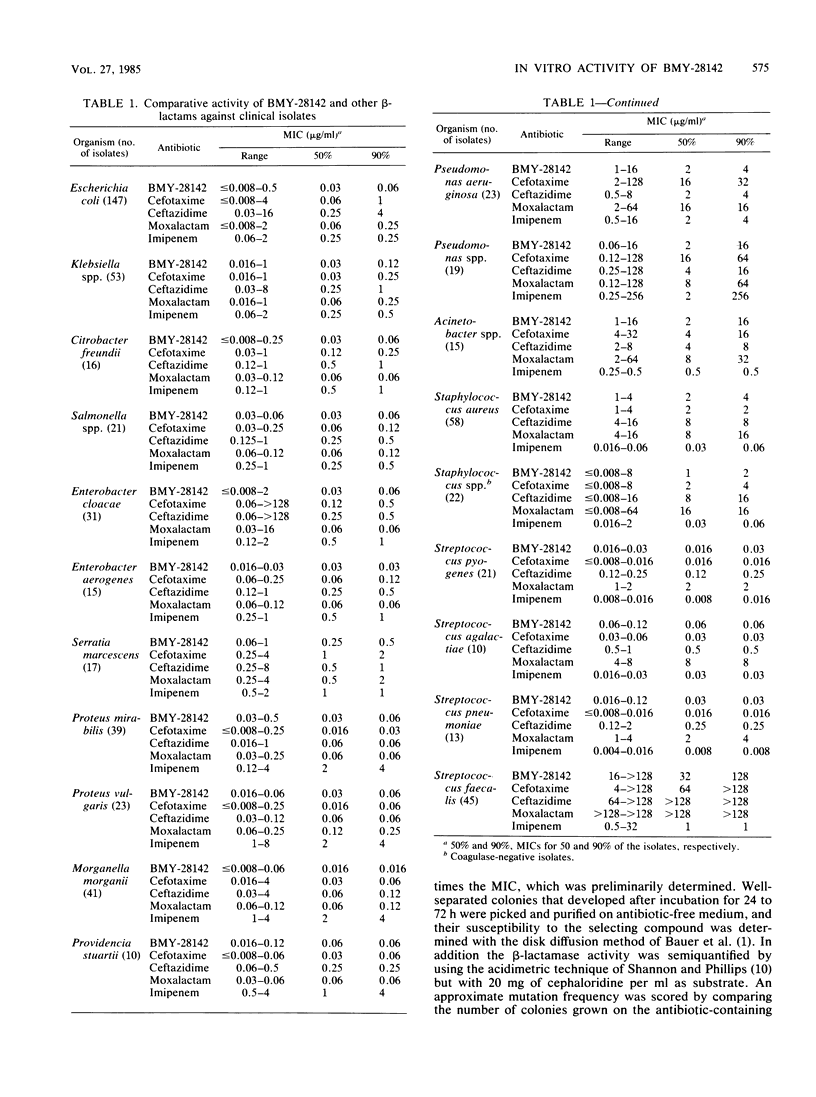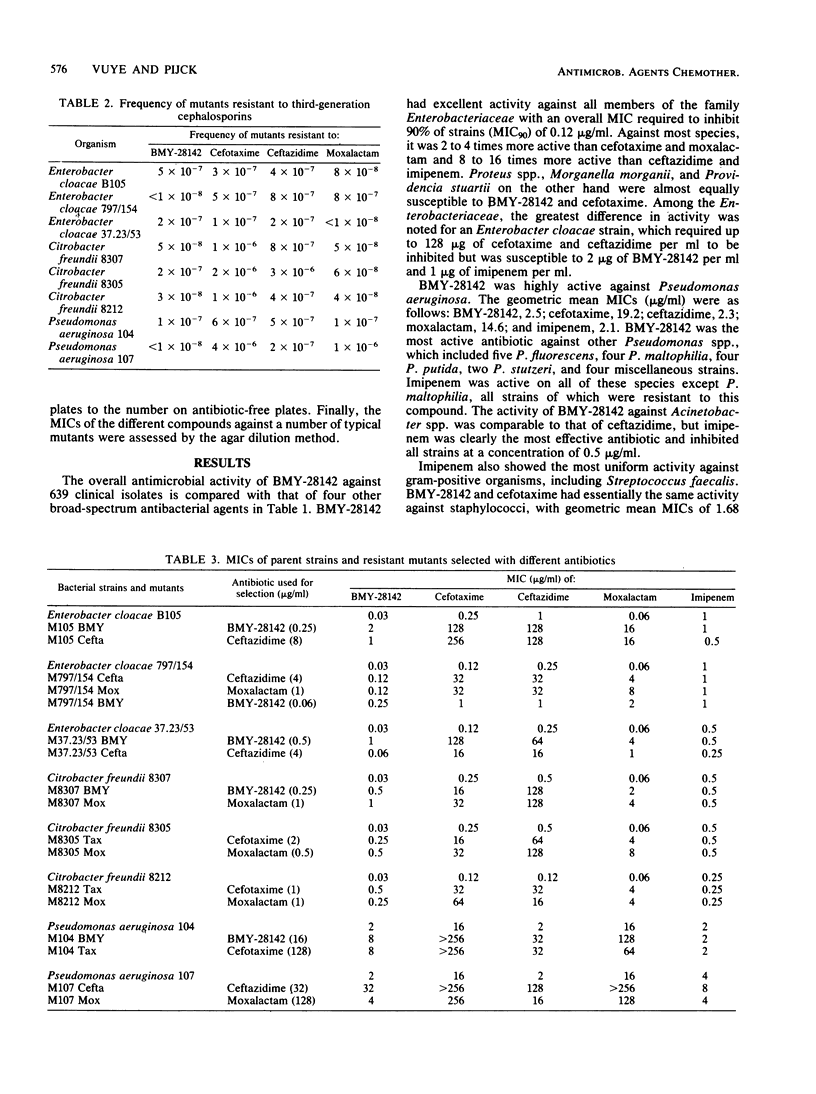Abstract
The in vitro activity of BMY-28142 was compared with that of cefotaxime, ceftazidime, moxalactam, and imipenem against 639 clinical isolates and a number of in vitro-selected resistant mutants. BMY-28142 was the most potent compound against the members of the family Enterobacteriaceae with a MIC for 90% of the strains of 0.12 micrograms/ml. The activity against Pseudomonas aeruginosa was comparable to that of ceftazidime and imipenem. Strains of staphylococci were moderately susceptible to BMY-28142 (MIC required to inhibit 90% of strains, 4 micrograms/ml), but Streptococcus faecalis isolates were resistant. The activity of the five compounds was inoculum dependent for several gram-negative species. By a single-step selection procedure, resistant mutants were selected from strains of Citrobacter freundii, Enterobacter cloacae, and P. aeruginosa. The mutant frequencies with the cephalosporins, including BMY-28142, ranged between 10(-6) and 10(-8). BMY-28142 was the most active cephalosporin against these resistant organisms, most of them strong beta-lactamase producers. It inhibited all mutants of C. freundii and E. cloacae at 2 micrograms/ml and all mutants of P. aeruginosa at 32 micrograms/ml. Imipenem on the other hand was as active on all of these resistant organisms as on the parent strains.
Full text
PDF



Selected References
These references are in PubMed. This may not be the complete list of references from this article.
- Bauer A. W., Kirby W. M., Sherris J. C., Turck M. Antibiotic susceptibility testing by a standardized single disk method. Am J Clin Pathol. 1966 Apr;45(4):493–496. [PubMed] [Google Scholar]
- Brooks G. F., Barriere S. L. Clinical use of the new beta-lactam antimicrobial drugs. Practical considerations for physicians, microbiology laboratories, pharmacists, and formulary committees. Ann Intern Med. 1983 Apr;98(4):530–535. doi: 10.7326/0003-4819-98-4-530. [DOI] [PubMed] [Google Scholar]
- Collatz E., Gutmann L., Williamson R., Acar J. F. Development of resistance to beta-lactam antibiotics with special reference to third-generation cephalosporins. J Antimicrob Chemother. 1984 Sep;14 (Suppl B):13–21. doi: 10.1093/jac/14.suppl_b.13. [DOI] [PubMed] [Google Scholar]
- Mouton R. P., Bongaerts G. P., van Gestel M. Comparison of activity and beta-lactamase stability of cefotaxime with those of six other cephalosporins. Antimicrob Agents Chemother. 1979 Dec;16(6):757–760. doi: 10.1128/aac.16.6.757. [DOI] [PMC free article] [PubMed] [Google Scholar]
- Sanders C. C. Inducible beta-lactamases and non-hydrolytic resistance mechanisms. J Antimicrob Chemother. 1984 Jan;13(1):1–3. doi: 10.1093/jac/13.1.1. [DOI] [PubMed] [Google Scholar]
- Sanders C. C., Sanders W. E., Jr Emergence of resistance during therapy with the newer beta-lactam antibiotics: role of inducible beta-lactamases and implications for the future. Rev Infect Dis. 1983 Jul-Aug;5(4):639–648. doi: 10.1093/clinids/5.4.639. [DOI] [PubMed] [Google Scholar]
- Seeberg A. H., Tolxdorff-Neutzling R. M., Wiedemann B. Chromosomal beta-lactamases of Enterobacter cloacae are responsible for resistance to third-generation cephalosporins. Antimicrob Agents Chemother. 1983 Jun;23(6):918–925. doi: 10.1128/aac.23.6.918. [DOI] [PMC free article] [PubMed] [Google Scholar]
- Shannon K. P. New cephalosporins and related compounds. J Antimicrob Chemother. 1980 Jul;6(4):430–433. doi: 10.1093/jac/6.4.430. [DOI] [PubMed] [Google Scholar]
- Shannon K., Phillips I. beta-Lactamase detection by three simple methods: Intralactam, nitrocefin and acidimetric. J Antimicrob Chemother. 1980 Sep;6(5):617–621. doi: 10.1093/jac/6.5.617. [DOI] [PubMed] [Google Scholar]
- Slack M. P. Antipseudomonal beta-lactams. J Antimicrob Chemother. 1981 Sep;8(3):165–170. doi: 10.1093/jac/8.3.165. [DOI] [PubMed] [Google Scholar]
- Then R. L., Angehrn P. Trapping of nonhydrolyzable cephalosporins by cephalosporinases in Enterobacter cloacae and Pseudomonas aeruginosa as a possible resistance mechanism. Antimicrob Agents Chemother. 1982 May;21(5):711–717. doi: 10.1128/aac.21.5.711. [DOI] [PMC free article] [PubMed] [Google Scholar]
- Towner K. J. Emerging bacterial resistance to the newer cephalosporins. J Antimicrob Chemother. 1984 May;13(5):526–527. doi: 10.1093/jac/13.5.526. [DOI] [PubMed] [Google Scholar]


